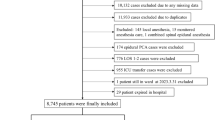Abstract
Purpose
Optimal postoperative pain management following minimally invasive surgical repair of pectus excavatum is not established. We compared efficacy and adverse effects in patients treated with patient-controlled analgesia (PCA) with those treated with continuous infusion (CI) with morphine in addition to nonsteroidal anti-inflammatory drugs.
Methods
33 patient records were examined retrospectively: 21 given PCA and 12 CI with morphine. Main outcome variables were used doses of morphine, pain scores every 3 h and adverse effects.
Results
Median (range) used morphine dose was 0.58 (0.21–1.12) and 0.52 (0.34–0.84) mg/kg on the day 1 and 0.3 (0.02–0.6) and 0.33 (0.09–0.53) mg/kg on the day 2 in PCA and CI groups, respectively (p > 0.05). Pain scores were within moderate and low levels during 42 h after surgery and did not differ between the groups. Median (range) oxygen saturation was 96.5 (93–100) and 97 (94–100) in PCA and CI groups, respectively (p > 0.05). Additional oxygen therapy was required in 14.3% in PCA group and 25% in CI group (p > 0.05). The incidence of pulmonary adverse effects was rare and did not differ between the groups.
Conclusion
Both methods of systemic analgesia in addition to non-opioid analgesics were equally effective and resulted in a low incidence of pulmonary adverse effects.


Similar content being viewed by others
References
Coln E, Carrasco J, Coln D (2006) Demonstrating relief of cardiac compression with the Nuss minimally invasive repair for pectus excavatum. J Pediatr Surg 41:683–686
Lawson ML, Mellins RB, Tabangin M, Kelly RE Jr, Croitoru DP, Goretsky MJ, Nuss DJ (2005) Impact of pectus excavatum on pulmonary function before and after repair with the Nuss procedure. J Pediatr Surg 40:174–180
Futagawa K, Suwa I, Okuda T, Kamamoto H, Sugiura J, Kajikawa R, Koga Y (2006) Anesthetic management for the minimally invasive Nuss procedure in 21 patients with pectus excavatum. J Anesth 20:48–50
Cucchiaro G, Adzick SN, Rose JB, Maxwell L, Watcha M (2006) A comparison of epidural bupivacaine-fentanyl and bupivacaine-clonidine in children undergoing the Nuss procedure. Anesth Analg 103:322–327
Cucchiaro G, Farrar JT, Guite JW, Li Y (2006) What postoperative outcomes matter to pediatric patients? Anesth Analg 102:1376–1382
Groeben H (2006) Epidural anesthesia and pulmonary function. J Anesth 20:290–299
Ballantyne JC, Carr DB, de Ferranti S, Suarez T, Lau J, Chalmers TC, Angelillo IF, Mosteller F (1998) The comparative effects of postoperative analgesic therapies on pulmonary outcome: cumulative meta-analyses of randomized, controlled trials. Anesth Analg 86:598–612
Liu SS, Wu CL (2007) Effect of postoperative analgesia on major postoperative complications: a systematic update of the evidence. Anesth Analg 104:689–702
Butkovic D, Kralik S, Matolic M, Kralik M, Toljan S, Radesic L (2007) Postoperative analgesia with intravenous fentanyl PCA vs epidural block after thoracoscopic pectus excavatum repair in children. Br J Anaesth 98:677–681
St Peter SD, Weesner KA, Sharp RJ, Sharp SW, Ostlie DJ, Holcomb GW III (2008) Is epidural anesthesia truly the best pain management strategy after minimally invasive pectus excavatum repair? J Pediatr Surg 43:79–82
Rugyte D, Kokki H (2007) Intravenous ketoprofen as an adjunct to patient-controlled analgesia morphine in adolescents with thoracic surgery: a placebo controlled double-blinded study. Eur J Pain 11:694–699
McGrath PA, Seifert CE, Speechley KN, Booth JC, Stitt L, Gibson MC (1996) A new analogue scale for assessing children’s pain: an initial validation study. Pain 64:435–443
Inge TH, Owings E, Blewett CJ, Baldwin CE, Cain WS, Hardin W, Georgeson KE (2003) Reduced hospitalization cost for patients with pectus excavatum treated using minimally invasive surgery. Surg Endosc 17:1609–1613
Weber T, Mätzl J, Rokitansky A, Klimscha W, Neumann K, Deusch E (2007) Superior postoperative pain relief with thoracic epidural analgesia versus intravenous patient-controlled analgesia after minimally invasive pectus excavatum repair. J Thorac Cardiovasc Surg 134:865–870
Peters JW, Bandell Hoekstra IE, Huijer Abu-Saad H, Bouwmeester J, Meursing AE, Tibboel D (1999) Patient controlled analgesia in children and adolescents: a randomized controlled trial. Paediatr Anaesth 9:235–241
Elia N, Lysakowski C, Tramèr MR (2005) Does multimodal analgesia with acetaminophen, nonsteroidal antiinflammatory drugs, or selective cyclooxygenase-2 inhibitors and patient-controlled analgesia morphine offer advantages over morphine alone? Meta-analyses of randomized trials. Anesthesiology 103:1296–1304
Marret E, Kurdi O, Zufferey P, Bonnet F (2005) Effects of nonsteroidal antiinflammatory drugs on patient-controlled analgesia morphine side effects: meta-analysis of randomized controlled trials. Anesthesiology 102:1249–1260
Voepel-Lewis T, Marinkovic A, Kostrzewa A, Tait AR, Malviya S (2008) The prevalence of and risk factors for adverse events in children receiving patient-controlled analgesia by proxy or patient-controlled analgesia after surgery. Anesth Analg 107:70–75
Author information
Authors and Affiliations
Corresponding author
Rights and permissions
About this article
Cite this article
Rugyte, D.C., Kilda, A., Karbonskiene, A. et al. Systemic postoperative pain management following minimally invasive pectus excavatum repair in children and adolescents: a retrospective comparison of intravenous patient-controlled analgesia and continuous infusion with morphine. Pediatr Surg Int 26, 665–669 (2010). https://doi.org/10.1007/s00383-010-2619-0
Accepted:
Published:
Issue Date:
DOI: https://doi.org/10.1007/s00383-010-2619-0




